Only trailing Harris County in total population, Tarrant County is packed with properties of all sizes and varieties. As one half of the burgeoning Dallas-Ft. Worth Metroplex, Tarrant County has some of the fastest-growing communities in Texas. This growth, combined with historic prosperity, has led to a growth in property taxes over the past decade. The Tarrant County Appraisal District (TAD) is in charge of assessing and collecting all taxes. Recent studies have found that at least 19% of Tarrant County residential property was overvalued, and there is a strong possibility that commercial property has been raised into even higher figures.
Tarrant County Residential Property Edged Up 1.6%
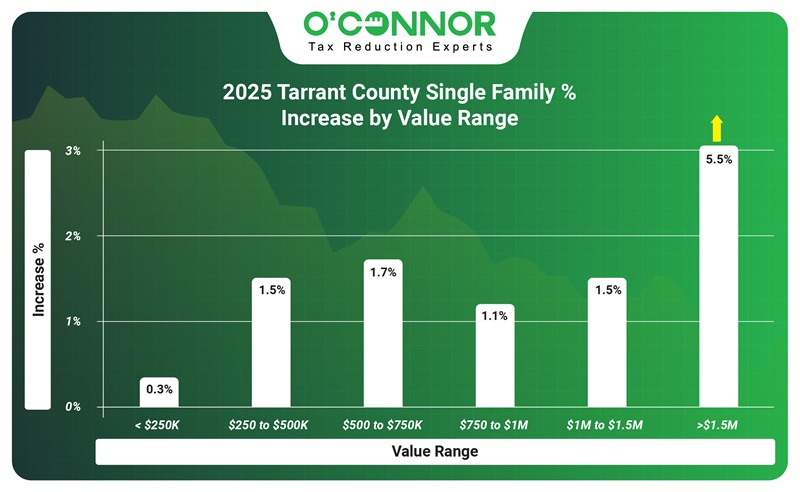
Single-family homes in Tarrant County totaled a staggering $229.09 billion in notice value in 2025. While this value is only a 1.6% improvement over 2024’s total, it does represent an expansion of over $3 billion. The biggest growth by a wide margin was for luxury residences, which scored 5.5%. This implies that more properties worth over $1.5 million are being built in Ft. Worth and surrounding areas than ever before. Homes in the price range for the average homeowner, those worth between $250,000 and$500,000, increased a conservative 1.5%.
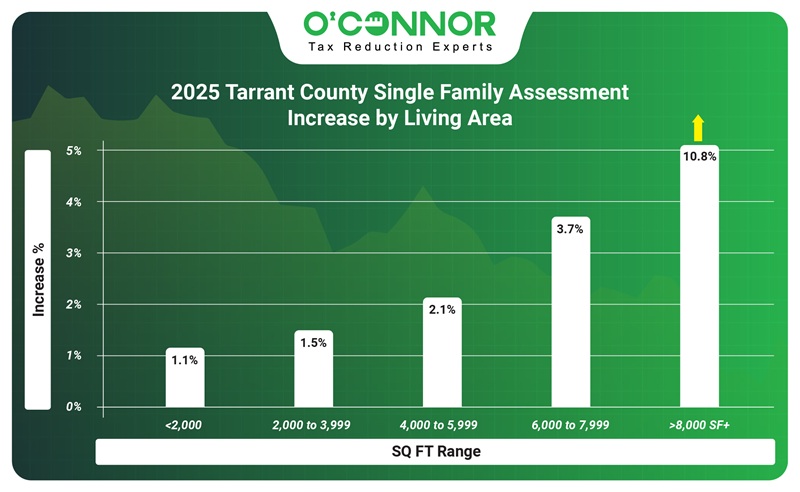
When broken down by size, it is pretty apparent that the value of mammoth homes is increasing at a good clip. For homes over 8,000 square feet, there was a 10.8% increase in value created, or $291.18 million. Homes between 6,000 and 7,999 square feet added $176.12 million, or 3.7%. With a total of $103.28 billion, homes sized between 2,000 and 3,999 square feet were the most valuable in Tarrant County and added to their lead with a jump of 1.5%.
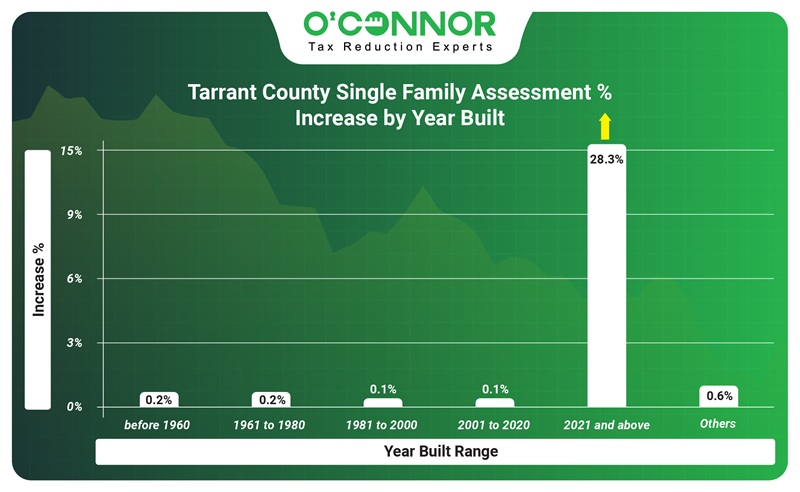
Tarrant County got a very strong indicator of the health of their community and the brightness of their future in 2025, as the value of new construction sprang up a dramatic 28.3%. This solidifies homes built between 2021 and the present as already 7% of all residential properties in the county. This is a fantastic illustration of a vibrant and developing community. The biggest chunk of value currently on the books is $83.08 billion for homes built between 2001-2020. Outside of new and recent construction, property values only grew fractions of a percent.
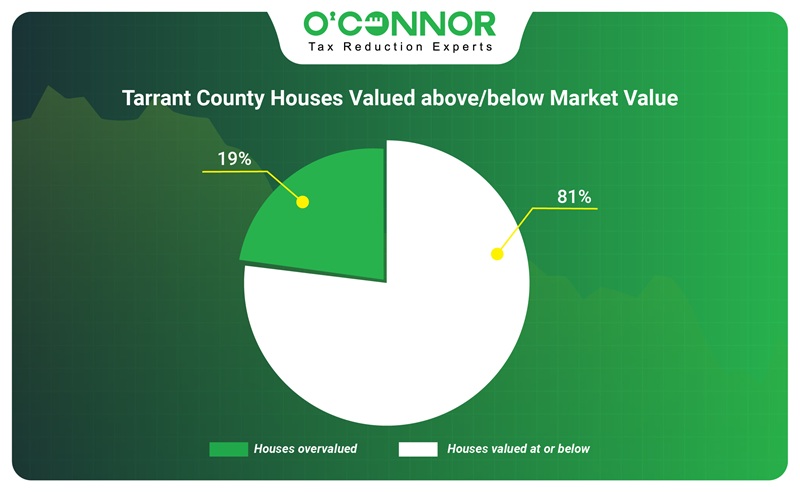
While they can also be disputed on grounds of unequal appraisal, the majority of property tax protests involve incorrect valuation of property. Tarrant County shows why it is important to protest your taxes every year, as TAD released information that 19% of all homes were overvalued when it comes to property taxes. This is a marked improvement from 2024, where 44% of homes were overvalued. Hopefully, this indicates that TAD is making progress toward improved accuracy and transparency, rather than continuing to obscure or manipulate data.
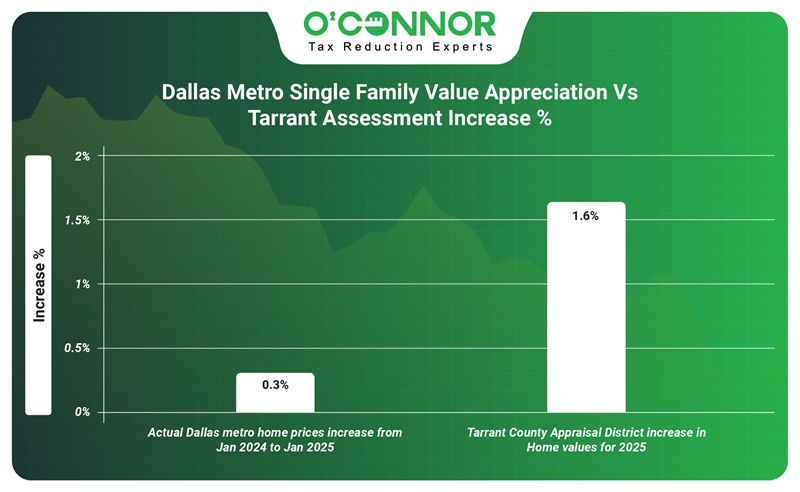
In another condemnation of TAD’s numbers, a study by the MetroTex Association of Realtors suggests that properties in the Metroplex are selling at an increase of only .3%, rather than the 1.6% put forward by TAD. While this might seem like a small difference, it could certainly have implications for the entirety of TAD’s data. When combined with the 19% overvaluation for homes and the staggering increase in commercial properties discussed below, it certainly encourages residents to protest their taxes.
Taxable Value for Tarrant County Business Increase 25%
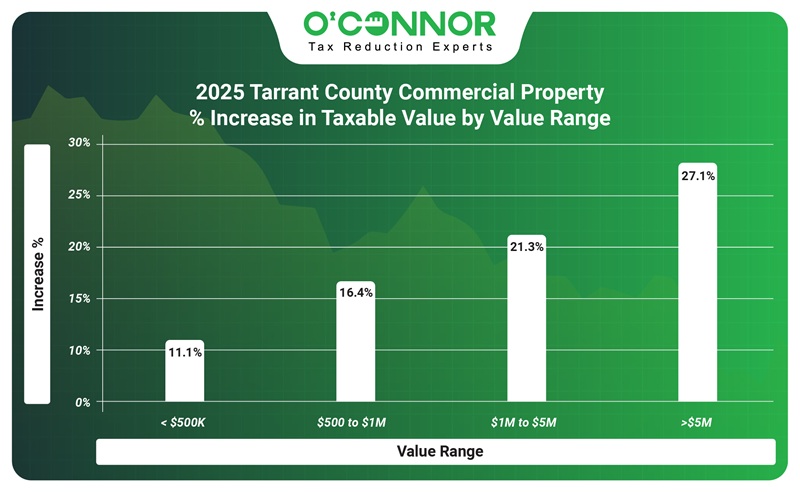
Resident property values have thankfully stabilized, especially those of working and middle-class people. The same cannot be said for the various businesses and commercial properties around Tarrant County. Commercial property values thundered up a spectacular 25% in 2025. While this could be seen as a good thing in a vacuum, we have already demonstrated that TAD has a problem with overvaluing homes. The biggest increase was seen by the largest businesses, as those worth over $5 million saw their taxable value raised 27.1%. Businesses worth between $1 and $5 million came in second, with a strong 21.3% jump. Even the smallest of businesses saw their value move upwards at 11.1%.
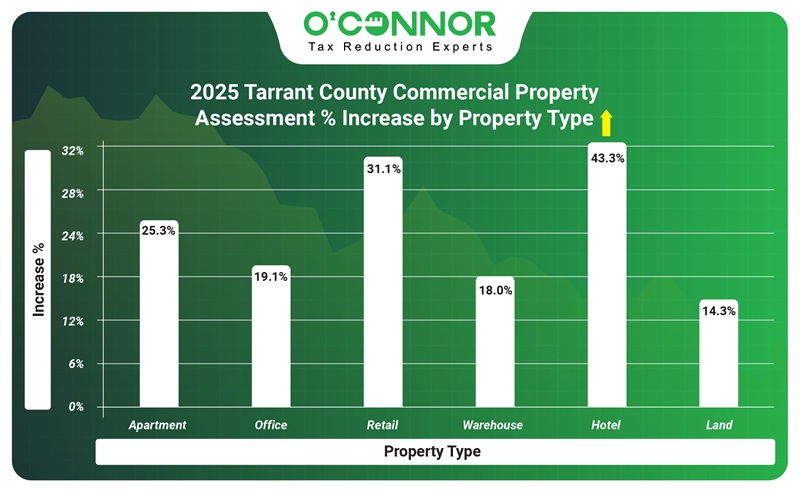
Tarrant County added $14.40 billion in business value in 2025, bringing the estimated total to $71.40 billion. These numbers illustrate that business is booming in Tarrant County. When broken down over various industries, it is clear to see that the 25.3% overall improvement is not too lopsided. The biggest grower was the hotel industry, which added 43.3% to their value, an amazing jump. That was only a gain in percentage, as impressive as it was. The biggest jump in total hard value was in apartments. Already the most valuable of commercial properties, apartments added $8.16 billion, or 25.3%. Though not to the same degree, all recorded industries made out like bandits, with even the lowest land gaining a superb 14.3%. These gaudy numbers should be reexamined, making them perfect for a detailed property tax appeal.
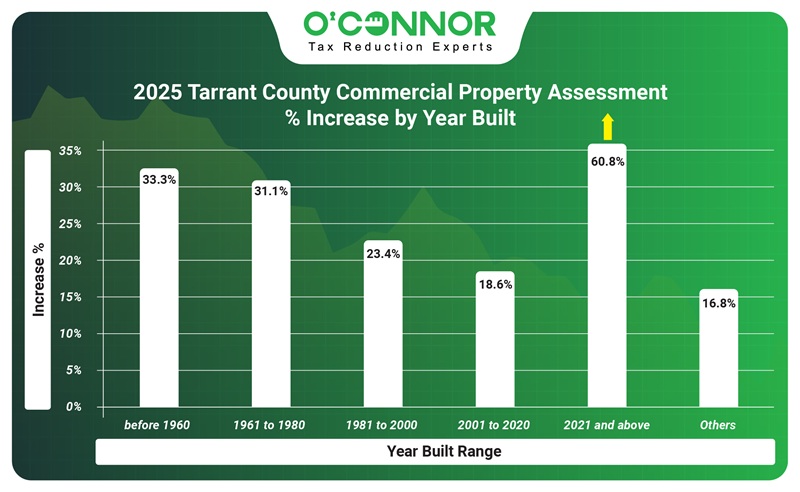
Tarrant County paradoxically saw massive jumps in the value of the oldest and the newest commercial properties, with 33.3% and 60.8% respectively. This certainly illustrates a strong demand for business and other such buildings. But while this dichotomy looks good on a graph, the true drivers of commerce are buildings built between 1981 and 2020. Representing 36% of all of Tarrant County’s commercial worth, properties constructed between 2000 and 2020 were able to add 18.6% more. Those built between 1981 and 2000 had the best of both worlds, surging 23.4% while also maintaining second place in total worth.
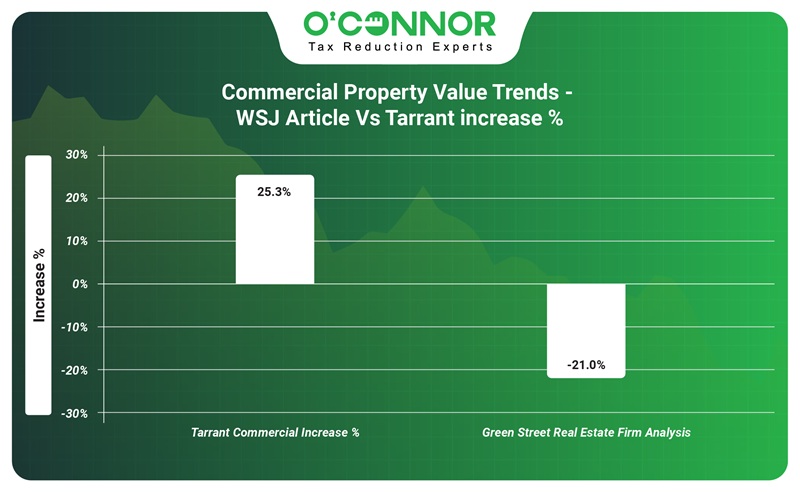
While we have seen several graphs that appear to be good news for businesses, there comes one of the biggest monkey wrenches. There is the possibility that these numbers have been pumped by TAD. According to leading commercial property firm Green Street Real Estate, the nation’s commercial property lost 21% of value in 2025. This is due to a variety of market factors, including interest rates and difficulty in borrowing money. Considering the stark disparity between a 21% loss and a 25.3% gain, it is not out of the realm of possibility that the true number is hidden in the massive gray area. This is a textbook situation to deploy a property tax protest, as the potential savings are so high that it would be criminal to pass it up.
Apartments Gain 25% in 2025

The biggest commercial property type in Tarrant County is currently apartments and other multi-family homes. This is only set to expand as more people move into the DFW metroplex, along with skyrocketing property values pushing up prices for every piece of living space. This demand can be seen in how quickly new and recent construction of apartments has staked a major market share. Currently, 13% of all apartment value was constructed from 2021 or later, and this portion of the market is gaining by leaps and bounds.
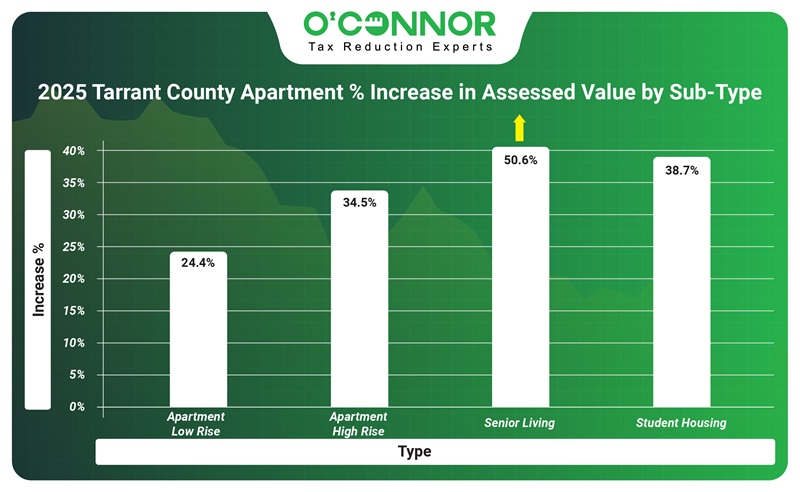
The largest apartment type by far in Tarrant County is low-rise. These were valued at $38.14 billion, 93.9% of the total apartment value. Low-rise apartments even gained over 24.4% more value in 2025. While all types of apartments saw huge jumps in value, senior living were the biggest risers with 50.6%. High-rise apartments were the second-most valuable type, and grew at a strong 34.7%.
Tarrant County Offices Worth Over $10 Billion
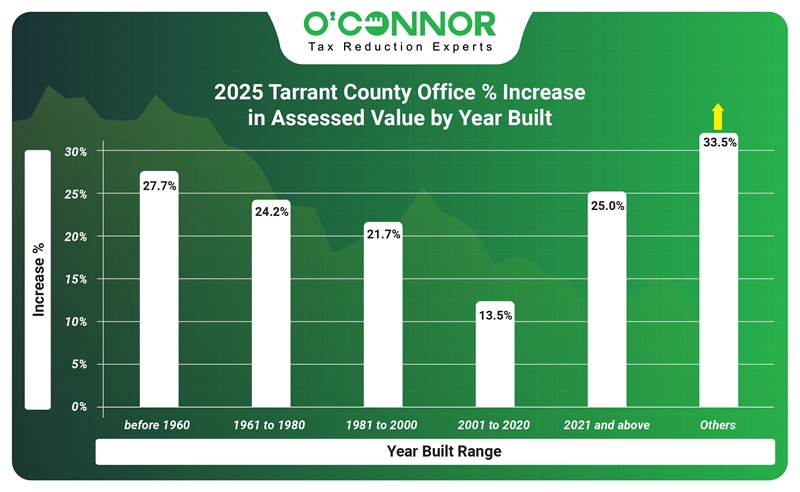
Now out of the pandemic’s shadow, the demand for offices is again on the rise. Appraised at a combined worth of $10.78 billion, offices also soared in value by 19.1%. With no regard for age, all eras of apartment construction improved their worth. The smallest increase was seen for those built between 2002 and 2020, with 13.5%, though buildings constructed in this period make up the majority of apartment property as a whole. The two biggest increases were seen with the oldest and newest offices, an illustration of new construction and renovation both gaining steam in Tarrant County.
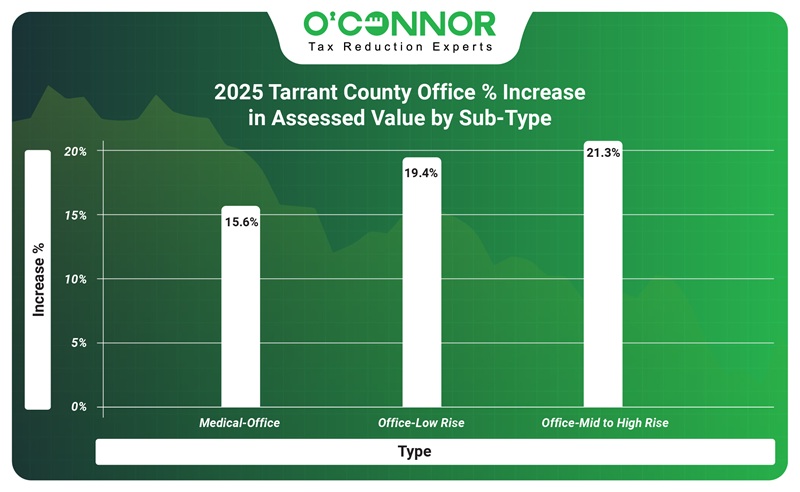
Just like the age of construction, offices of all types and categories increased their worth in 2025. The majority of assessed value is in low-rise buildings, with $4.76 billion. High-rise and medical offices were not far behind, with $3.57 billion and $2.45 billion respectively. High-rise office buildings were able to land an increase of 21.3%.
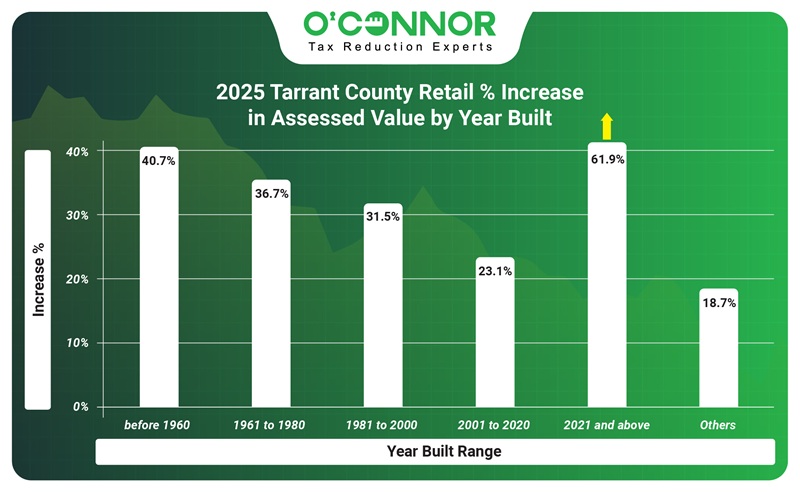
Retail is another set of commercial properties that are making an impressive rebound after a few years of a downturn. Retail properties expanded 31.1% across the board, scoring a total value of $9.30 billion. Like offices, the trend of refurbishment and new construction continues, as buildings constructed before 1961 and those after 2021 saw growth of 40.7% and 61.9% respectively. Retail spaces built between 1981 and 2021 still account for a combined 67% of the value.
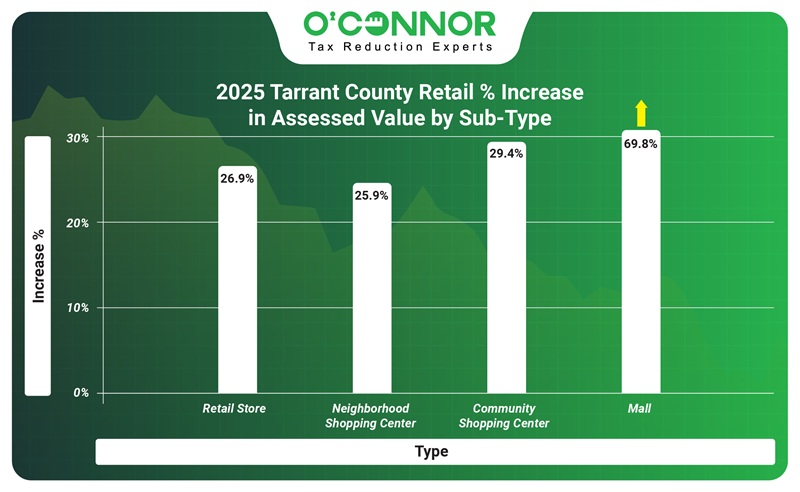
Shopping centers of all sorts seem to be back in a big way. Combining for an assessed value of $6.48 billion, community and neighborhood shopping centers also saw respective growths of 29.4% and 25.9%. Malls experienced a notable resurgence in 2025, soaring in value by 69.8%. General retail spaces were also able to jump up by 26.9%. Retail combined value surged to $9.30 billion.
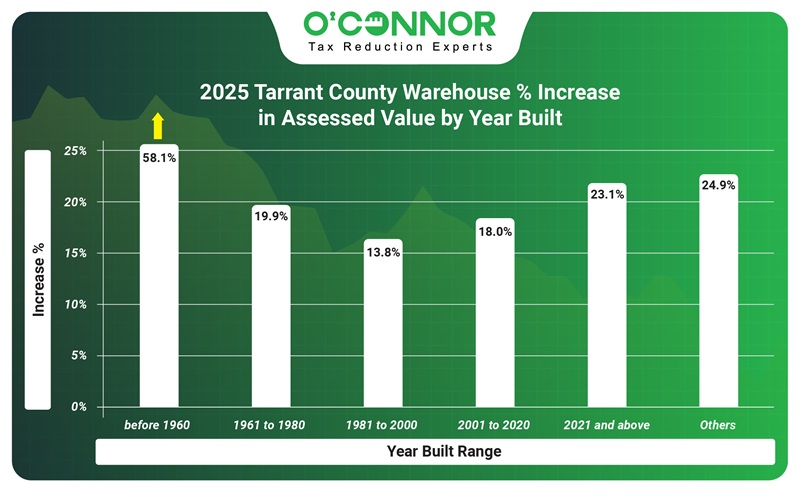
Warehouses are often cited as being recession-proof, and even with some economic woes, this adage proved true in 2025. Warehouse value rose a combined 18%, achieving a worth of $1.53 billion. Again, new construction and the renovation of older buildings were two of the driving forces in this rebound. Buildings constructed after 2021 already account for 13% of all warehouse value and added 23.1% in 2025. Most value is still held by those built between 1981 and 2020, but it seems that the new economic tide is rising all boats when it comes to warehouses.
Putting it All Together
When we aggregate all of this information and try to read the tea leaves, it is obvious that commercial properties are the story for Tarrant County in 2025. All business properties combined for a growth rate of 25%. If we were looking at income or an increase in market share with that number, then we would know that Tarrant County’s economy is going strongly. But, to throw some cold water on the situation, it should be reinforced that these numbers come from TAD. They have a vested interest in raising the tax base and commercial properties are individually the juiciest of prizes to be taxed.
There is a way for both home and business owners to turn this in their favor. Property tax protests allow residents to have their property reassessed. Remember that TAD does not appraise businesses individually, but uses historical data, mass appraisals, and computer models to estimate what a property is worth. A property tax appeal can cut through the illusions and get to the hard facts of property values.
This is even more important for businesses, as so much money can be on the line for every valuation. While tax rates cannot be lowered, a smaller valuation means a smaller tax bill. Businesses also tend to protest their taxes annually, as it is an easy form of cost reputation. O’Connor specializes in property tax appeals. In fact, we are one of the largest firms that focuses on it. Let us run your property tax appeal process for you. We will do so annually, building on each year’s evidence and savings to bring about better outcomes in the future.

